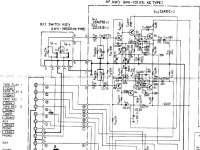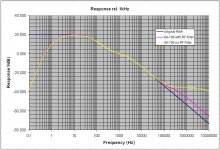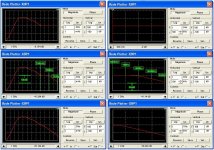Nice test equipment, Richard. Your active line conditioner looks impressive also. I have somewhat similar test equipment, but not as exotic as your 'network analyzer', still I don't think that even your equipment will show what Bybee does for line conditioning. It is just too 'exotic', to easily measure.
Hi Richard,
My, my ... what a lovely collection of test equipment you have!
I have never seen some of those brands up here - and I have been looking!
-Chris
The one in the middle left is the Shibasoku 725D. That analyzer with a bit of tweaking beats the pants off the AP2722, lower right, at -120dB THD+N. But it only does THD and level measurements. Not bad for an 80's design.
IMHO..... the PA/dac and speaker would be in same enclosure... no speaker cables.
<snip>
In this regard, the Hi-End is where Hi-Rez is at and HD downloads.
Minor problem tho, audiophiles don't want to buy that sort of product. Active speakers have been available for decades and those have not sold well outside the studio either. Hasn't stopped Meridian trying tho. But I can't see Dave Wilson launching an all in one, even if JC would do the electronics for it.
Richard,
You just described what it is I am trying to accomplish with my speakers, everything but the source storage inside the speaker enclosure. Not an easy thing to do if the speaker is not rather large to fit all the electronics inside the enclosure and still have air space for the speaker to work with. On a consumer level they have been told by marketing that the speakers don't need to be more than a tiny small speaker and this is one of those issues that have to be overcome on a consumer level. Here in DIY land that really isn't an issue but over on the consumer side it surely is now. And what are you going to use, WiFi seems to be out, and then you have Bluetooth and the licensing to deal with. USB with conversion is another thing to think about. This is surely not a simple problem to solve.
You just described what it is I am trying to accomplish with my speakers, everything but the source storage inside the speaker enclosure. Not an easy thing to do if the speaker is not rather large to fit all the electronics inside the enclosure and still have air space for the speaker to work with. On a consumer level they have been told by marketing that the speakers don't need to be more than a tiny small speaker and this is one of those issues that have to be overcome on a consumer level. Here in DIY land that really isn't an issue but over on the consumer side it surely is now. And what are you going to use, WiFi seems to be out, and then you have Bluetooth and the licensing to deal with. USB with conversion is another thing to think about. This is surely not a simple problem to solve.
Esperado, I too, found that battery operation can sound better, all else being equal. I found it with both FM and CD playback, and I have run through lots and lots of batteries to listen this way.
I think it is something in the AC power supplies that we normally make, that we are overlooking. I do know, that the CTC Blowtorch which has just about every active and passive addition to the power supply, seems to do the job properly enough, very, very close to actual floating battery operation. Of course, the problem with batteries, besides cost, and recharging hassle, is the capacity of the batteries themselves, i.e. larger batteries often sound better than smaller batteries, especially on CD. I played with this for years, but gave up in disgust when I could not keep my lead-acid gel cells functioning over time, no matter what the care I took.
I think it is something in the AC power supplies that we normally make, that we are overlooking. I do know, that the CTC Blowtorch which has just about every active and passive addition to the power supply, seems to do the job properly enough, very, very close to actual floating battery operation. Of course, the problem with batteries, besides cost, and recharging hassle, is the capacity of the batteries themselves, i.e. larger batteries often sound better than smaller batteries, especially on CD. I played with this for years, but gave up in disgust when I could not keep my lead-acid gel cells functioning over time, no matter what the care I took.
All-in-one will introduce heavy magnetic fields and interferences.
What do you mean by 'heavy' in this context. If we could build drive units that could be placed next to a CRT 15 years ago surely any problem with stray flux was long ago solved?
I would not recommend combining speakers and amps, preamps, and DAC's together, mostly because of the vibration, and its secondary effects. The general trend is to combine DAC's, preamps, and power amps in one package, and that should be OK, IF the analog part is not ignored as far as design quality.
Minor problem tho, audiophiles don't want to buy that sort of product. Active speakers have been available for decades and those have not sold well outside the studio either. Hasn't stopped Meridian trying tho. But I can't see Dave Wilson launching an all in one, even if JC would do the electronics for it.
None of that matters today.... audiophiles must follow the leaders in industry. My comments are about the larger view of audio-video-data as a whole.
Hi-End is another story.... they are looking for the nitches to play in. I dont see seperates going away completely.... it is not where mainstream is going.
THx-RNMarsh
Last edited:
Nice test equipment, Richard. Your active line conditioner looks impressive also. I have somewhat similar test equipment, but not as exotic as your 'network analyzer', still I don't think that even your equipment will show what Bybee does for line conditioning. It is just too 'exotic', to easily measure.
If I knew the principles involved, it could be measured. I have 3 analyzers with very high precision and resolution. If other gear is needed it can be rented/bought. BTW - I do have HP training on their network analyzer. So, that one I am very confident with.
Do you want it measured?
THx-RNMarsh
Last edited:
Well Richard,
More people were listening to that basic circuit than you can imagine. Many may still be doing so!
Still, examining that old circuit would be a useful lesson for the younger, technically minded folks. After all, this is probably more common out there than your basic 4558 MM amplifier. What do you think ?
Hi Chris,
I dont know who would find it useful today nor in what way. We know what it does. High low freq distortion, poor riaa, noise, overload etc.
One of the things that I test on RIAA preams is their overload margins, as I consider this a crucial -real life- spec.
I had an SA-706 on my bench two months ago (SA-706 is identical to SA-7700, save for wooden side panels).
This humble MM RIAA pre from Pioneer is specified with an Overload Margin (for 0.01% THD) of 37dB/1kHz rel it’s stated sensitivity of 2.5mV or 31dB rel 5mV/1kHz.
I measured (for 1% THD) the OM as 213mVrms/1kHz. This is 38.6dB rel it’s stated sensitivity of 2.5mV or 32.6dB rel 5mV.
At 20Hz, overload (1%THD) occurred at 22mVrms and at 20kHz overload (1%THD) occurred at 1080mVrms. Thus at 20Hz and 20kHz, overload falls approx. 8dB behind the values predicted by the RIAA gain curve
Not a stellar OL margin but quite adequate, certainly much higher than the poor numbers found on many other (hi-priced not excluded) units. (*)
The RIAA response is really good.
With RF filter OFF, deviation from theoretical RIAA curve is –0.34dB to +0.13dB 20Hz to 20kHz.
With RF filter ON, deviation from theoretical RIAA curve is +0.04dB to +0.12dB 20Hz to 20kHz.
The hidden asset of this pre is how the output of the RIAA feedback network is tracking the preamplifier output in terms of distortion. No high excursions of THD and ugly waveforms rising suddenly up there, past an input signal level. Distortion increase occurs gradually.
This is not the simplest ever RIAA circuit. It is to their credit that they paid a lot of attention on the power supply lines.
Yes, of course. On the other hand, I am mostly interested in behavior of the real, complete audio chain, under real listening conditions. And it is possible to make it very clean and transparent. I always wonder when guys speak about RFI pick-up and audible radio modulations in a phono + phono preamp setup, something is very wrong, then.
Pavel
Look at the HF roll-off as implemented in practice on RIAA preamplifiers.
A lot of them follow the upper curve.
Some follow the middle and some the lower.
Some implement the roll-off above 100kHz passively at the input, some incorporate it in the RIAA network and some around one or more transistors.
George
(*) And many manufacturers specify overload for 1% or 3% THD.
Attachments
Last edited:
BTW - I do have HP training on their network analyzer. So, that one I am very confident with.
Do you want it measured?
I did so on a Rohde & Schwarz unit. Guess what? It's a resistor, wrapped in BS.
No Richard, you would not easily measure anything, and if you did, it would not be part of RLC interactions. It would be interesting if you wanted to just measure an individual Bybee device, but you don't need me for this.
The latest Bybee approach is entirely 'passive' with just a couple of paralleled caps as the basic filter, but that is my contribution, not Bybee's.
The Bybee, (and other)parts are very exotic, and cannot easily be measured with conventional test equipment, I know, I have tried.
The latest Bybee approach is entirely 'passive' with just a couple of paralleled caps as the basic filter, but that is my contribution, not Bybee's.
The Bybee, (and other)parts are very exotic, and cannot easily be measured with conventional test equipment, I know, I have tried.
There are two types of Bybee devices: The small one that SY tried, and the larger one that has an OBVIOUS internal resistor that nobody can easily buy.
SY did NOT disassemble the smaller unit, and IF he did, I seriously doubt that he would find anything that appeared to be a low cost resistor. However, the device measures EFFECTIVELY as a 0.025 ohm resistor, with modest inductance (nanoHenries), almost 0 capacitance, so where is the BEEF? '-)
I have seen the inside of one of these devices and I could not make out any detail, even with a 1000X microscope, yet there was order in the device interior. SY does not believe this, but I have seen it for myself. SY does not believe in exotic resistors, but I do.
SY did NOT disassemble the smaller unit, and IF he did, I seriously doubt that he would find anything that appeared to be a low cost resistor. However, the device measures EFFECTIVELY as a 0.025 ohm resistor, with modest inductance (nanoHenries), almost 0 capacitance, so where is the BEEF? '-)
I have seen the inside of one of these devices and I could not make out any detail, even with a 1000X microscope, yet there was order in the device interior. SY does not believe this, but I have seen it for myself. SY does not believe in exotic resistors, but I do.
Just unplug the signal wire between two gears, like a preamp and an amp, and measure the V between the grounds of the two devices. (of course no earth connected). You can even feel the AC with your hand in certain circumstance. Capacitive coupling between primary and secondary of the trasfos, i believe. We are not overlooking-it.I think it is something in the AC power supplies that we normally make, that we are overlooking.
C cores are better.
Richard, about active speakers, i'm going for it. But no way to double the active filter, neither to put-it in the enclosure. So, ouput of the active filter in digital, and one DAC for each speaker in each enclosure ? 6 for usual 3 ways enclosures ? Kind of expensive !
I did so on a Rohde & Schwarz unit. Guess what? It's a resistor, wrapped in BS.
Specifically the small Bybee you measured is a carbon nanotube resistor. You regularly report you could not measure any difference between it and any resistor. It is not that hard to measure the difference between just about any two resistors. So why didn't you see some differences?
http://www.nature.com/nature/journal/v401/n6753/full/401572a0.html for one example of the buzz on carbon nanotube resistors.
Last edited:
One of the things that I test on RIAA preams is their overload margins, as I consider this a crucial -real life- spec.
I had an SA-706 on my bench two months ago (SA-706 is identical to SA-7700, save for wooden side panels).
This humble MM RIAA pre from Pioneer is specified with an Overload Margin (for 0.01% THD) of 37dB/1kHz rel it’s stated sensitivity of 2.5mV or 31dB rel 5mV/1kHz.
I measured (for 1% THD) the OM as 213mVrms/1kHz. This is 38.6dB rel it’s stated sensitivity of 2.5mV or 32.6dB rel 5mV.
At 20Hz, overload (1%THD) occurred at 22mVrms and at 20kHz overload (1%THD) occurred at 1080mVrms. Thus at 20Hz and 20kHz, overload falls approx. 8dB behind the values predicted by the RIAA curve
Not a stellar OL margin but quite adequate, certainly much higher than the poor numbers found on many other (hi-priced not excluded) units. (*)
The RIAA response is really good.
With RF filter OFF, deviation from theoretical RIAA curve is –0.34dB to +0.13dB 20Hz to 20kHz.
With RF filter ON, deviation from theoretical RIAA curve is +0.04dB to +0.12dB 20Hz to 20kHz.
The hidden asset of this pre is how the output of the RIAA feedback network is tracking the preamplifier output in terms of distortion. No high excursions of THD and ugly waveforms rising suddenly up there, past an input signal level. Distortion increase occurs gradually.
This is not the simplest ever RIAA circuit. It is to their credit that they paid a lot of attention on the power supply lines.
George
(*) And many manufacturers specify overload for 1% or 3% THD.
That's quite respectable, as well as an easier schematic to follow.
About the only thing of concern for me (although there are plenty of upgrades possible) is the 220pF loading, which is already close to the recommended C for many cartridges. With the tonearm wiring and interconnects it's apt to be considerably higher.
I wonder how soon the rest of the signal chain overloads?
Last edited:
Some times an affect which is small at low freq (audio) will become larger or give clues when subjected to higher freqs. Look at the specs for the HP 8753D specs.... phase, magnitude etc. Resolves very fine quantitiies at 300KHz. Lower freq can use the Anritzu analyzers down to 10Hz.
If it is current operated device, such as current filtering as opposed to voltage noise filtering, that can be measured as ell. I can measure that and or noise to very low levels with other precision equipment.
But at that point, it better do a LOT of something to be worth a lot of my time put into it. Basically, I would have to hear/detect a change before being interested. Or a zillion people from all over the planet say they detect a change (for better or worse).
THx-RNMarsh
If it is current operated device, such as current filtering as opposed to voltage noise filtering, that can be measured as ell. I can measure that and or noise to very low levels with other precision equipment.
But at that point, it better do a LOT of something to be worth a lot of my time put into it. Basically, I would have to hear/detect a change before being interested. Or a zillion people from all over the planet say they detect a change (for better or worse).
THx-RNMarsh
Last edited:
- Status
- Not open for further replies.
- Home
- Member Areas
- The Lounge
- John Curl's Blowtorch preamplifier part II


